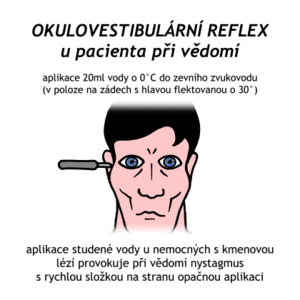Unconscious
From WikiLectures
Disorders of consciousness[edit | edit source]
- Qualitative (amnesia, disorientation, delirium),
- quantitative (apathy, somnolence, sopor, semicoma, subcoma, coma, deep coma and death),
- somnolence - a milder form of disturbance of consciousness, the patient must be aroused by irritation, address, touch and then is fully oriented,
- sopor - a more severe form of disturbance of consciousness where the patient can only be brought back to short-term consciousness by severe painful irritation,
- obnubilation - the sufferer is awake but unaware of their actions (e.g. in hypoglycaemia).
- in a patient with impaired consciousness, we actively look for symptoms that may lead to urgent surgical indication,
- the state of consciousness depends on the activity of the ARAS (activating reticular ascending system) - located in the rostral pontine, mesencephalon and thalamus,
- consciousness has two components - content (quality) and degree of alertness (vigilance).
Glasgow Coma Scale - GCS[edit | edit source]
- Assessment of level of consciousness regardless of the underlying neurological findings,
- it is the sum of three values for - eye opening, motor response and verbal response,
- the minimum is GCS 3 and the maximum is 15,
- eye opening is a total of 4 points (spontaneous, on address, on pain, not at all),
- verbal response is 5 points,
- motor response is 6 points (there is an important decerebrate - 2p, and decorticate - 3p),
- with a GCS < 7, we're talking coma,
- GCS < 8, intubation is appropriate,
- GCS < 13, we hospitalize.
Other unconscious investigations[edit | edit source]
- Lateralization',
- actively looking for signs of asymmetry - motor and pupillary,
- eyeball movements'',
- sometimes we find wandering eyeball movements, indicative of preserved oculomotor function, a good sign,
- pupils'',
- note size (recorded in mm), symmetry and response to illumination,
- anisocoria - indicative of n. III oppression at the margin of the tentorium,
- symmetrical miosis - if there is a decortication reaction to pain, it is indicative of central herniation,
- symmetric mydriasis without photoreaction - very advanced deterioration of trunk function,
- note size (recorded in mm), symmetry and response to illumination,
- Oculocephalic reflexes' - unconscious patient's head is turned (only when the spine is not injured!) and if the trunk is intact, the unconscious person fixes the gaze in one position,
- motor examination',
- monitor tone, reflexes, symmetry of spontaneous movements in response to pain,
- respiratory disturbances''.
Differential diagnosis[edit | edit source]
The list of causes is indicative !
Simply (for use over the patient) the Dozen causes of unconsciousness
- neurogenic causes'
- apoplexy, CSF, meningitis, encephalitis, brain tumors, epilepsy, SAK, thrombosis, embolism, air embolism, brain abscess, narcolepsy, cerebral coma, contusion.
- clinical picture - signs of lateralization, areactive pupils, anisocoria, extraocular motor or other brainstem reflexes are absent or asymmetrical, absent gaze, strabismus, signs of trauma are evident.
- primarily psychogenic causes' - psychogenic stupor - hysteria, deep hypnosis,
- abnormal neurological signs are absent, normal pupils, oculocephalic reflexes are absent, normal oculovestibular reflexes, eyes tightly closed, patient's hands do not fall on the face if dropped directly over it, history of psychiatric illness.
- exogenous causes'
- poisoning,
- ethanol, hypnotics, addictive substances, general anesthetics, mushrooms (amanita phalloides), CO, ...
- infections,
- meningitis, tetanus, botulism, anthrax gas, rabies, ...
- physicalcause,
- hypothermia, hyperthermia, electrocution, burn, cold, drowning,
- endogenous causes (metabolic)'
- toxic,
- hepatic, uraemia, pseudouraemia, eclampsia,
- endocrine,
- diabetic coma (hyperglycemia),
- nausea, vomiting, dehydration, acetone in breath, polyuria, rapid deep breathing, tachycardia,
- hypoglycaemia,
- sweating, tremor, hunger, weakness, headache, superficial respiration, tachycardia, elevated BP, moist skin, sudden onset,
- hyperosmolar - thirst, weakness, dehydration, hallucinations, delirium, convulsions,
- lactacidemic coma, thyrotoxic crisis, hypothyroid coma, pituitary coma, adrenal insufficiency coma (Addison), hypocalcemic coma (tetany), hypercalcemic coma.
- diabetic coma (hyperglycemia),
- cardiovascular causes
- coronary artery disease - cardiogenic shock.
- arrhythmias - atrial fibrillation with risk of thromboembolism.
- Grade III AV block - Morgagni-Adams-Stokes syndrome.
- ventricular tachycardia.
- sick-sinus syndrome,
- circulatory syncope - orthostatic collapse, carotid sinus syndrome (vagovagal reflex), aortic arch syndrome, subclavian "steal syndrome", vertebrobasilar insufficiency, dissecting aortic aneurysm, sinus tumour and valvular thrombus.
- Congenital heart defects,
- acute cardiac tamponade,
- hemorrhagic shock
- hypertensive crisis,
respiratory disorders.
- hypoxia, anoxia, hypocapnia (from hyperventilation), hypercapnia, pulmonary disease.
- disturbances of water and electrolyte balance,
- dis-equilibration sy (hyponatremia - water intoxication), severe dehydration - increase in blood viscosity, drop in blood pressure, hypochloremia, hypokalemia, hyperkalemia.
Care of the unconscious person[edit | edit source]
- Place the casualty in a stable position,
- after every 30 minutes in the stable position, it is recommended to turn the casualty onto the other side,
- assess circulation and respiration regularly; if necessary, initiate Basic Emergency CPR immediately
References[edit | edit source]
Related articles[edit | edit source]
- Consciousness assessment
- Glasgow Depth of Unconsciousness Scale
- Apalic syndrome
- Consciousness and its disorders
External links[edit | edit source]
References used[edit | edit source]
- BENES, Jiří. Materiály orl [online]. ©2007. [cit. 2009]. <http://jirben2.chytrak.cz/materialy/orl_jb.doc>.
- BYDŽOVSKÝ, Jan. First Aid. 2. edition. GRADA, 2001. pp. 18-19. ISBN 80-247-0099-9.

